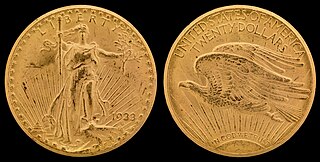 W
WThe 1933 double eagle is a United States 20-dollar gold coin. Although 445,500 specimens of this Saint-Gaudens double eagle were minted in 1933, none were ever officially circulated, and all but two were ordered to be melted down. However, 20 more are known to have been rescued from melting by being stolen and found their way into the hands of collectors before later being recovered. Nine of the recovered coins were destroyed, making this one of the world's rarest coins, with only 13 known specimens remaining—only one of which is privately owned.
 W
WThe American Buffalo, also known as a gold buffalo, is a 24-karat bullion coin first offered for sale by the United States Mint on June 22, 2006, and available for shipment beginning on July 13. The coin follows the design of the Indian Head nickel and has gained its nickname from the American Bison on the reverse side of the design. This was the first time ever that the United States Government has minted pure (.9999) 24-karat gold coins for the public. The coin has a legal tender (face) value of US$50. Due to a combination of the coin's popularity and the tremendous increase in the price of gold since its creation the coin's value has increased considerably in a short time of just a few years. The initial 2006 U.S. Mint price of the proof coin was $800. In 2007 the Mint proof coin was $899.95, $1,410.00 in 2009, and $2,010.00 in 2011.
 W
WThe American Liberty 225th Anniversary gold coin is a one-ounce gold coin minted to commemorate the 225th anniversary of the U.S. Mint. It was released on April 6, 2017. A companion series of one-ounce silver medals bearing the same designs was released on October 6 later that year.
 W
WThe American Liberty high relief gold coin is a one-ounce gold bullion coin issued by the United States Mint since 2015. This coin was the first 100 dollar gold coin to be issued by the US Mint.
 W
WThe Apollo 11 50th Anniversary commemorative coins were issued by the United States Mint in 2019 to commemorate the 50th anniversary of the first crewed landing on the Moon by Apollo 11 astronauts Neil Armstrong and Buzz Aldrin. Consisting of a gold half eagle, two different sizes of silver dollars, and a copper-nickel clad half dollar, each of the four was issued in proof condition, with all but the larger silver dollar also issued in uncirculated. The gold coins were struck at the West Point Mint, the silver at the Philadelphia Mint and the base metal half dollars at the mints in Denver and San Francisco.
 W
WThe Baltimore gold hoard was a discovery of gold coins by two teenage boys in Baltimore, Maryland in 1934.
 W
WBeaver Coins, also known in pioneer days as Beaver Money, were gold coins minted in Oregon in 1849. Their name comes from the prominent beaver depicted on the obverse of the coins. The currency contained 8% more gold than contemporary coins from the United States of America. Today these coins are quite rare and valuable.
 W
WThe Brasher Doubloon is a rare American doubloon of eight escudos worth sixteen dollars, privately minted in and after 1787.
 W
WCalifornia gold coinage is a broad category of privately-issued coin-like items that were used in place of official currency in the United States territory of California during the gold rush of 1849. Since the federal government reserves the right to issue legal tender coins, California gold coinage is a misnomer and actually references coin-like ingots with a stated tender value, tokens with a stated tender value (denominated), and tokens without a stated tender value (non-denominated). These items are only classified as an ingot if the value of the metal was close to the tender value marked on the piece. In spite of the misnomer, it is common practice among numismatists to label coin-like ingots and denominated tokens as 'coins' while labeling the non-denominated tokens as 'tokens'. Also, the small California Gold coins and tokens have been made in many locations other than California, often with a claim of being from California on the piece and these items are generally labeled as California Gold Coins or Tokens.
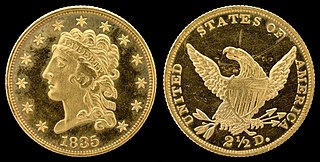 W
WThe Classic Head $2.50 gold coin is an American coin, also called a quarter eagle, minted from 1834-1839. It features Liberty on the obverse and an eagle on the reverse.
 W
WA double eagle is a gold coin of the United States with a denomination of $20. The coins are made from a 90% gold and 10% copper alloy and have a total weight of 1.0750 troy ounces.
 W
WThe eagle was a United States $10 gold coin issued by the United States Mint from 1792 to 1933.
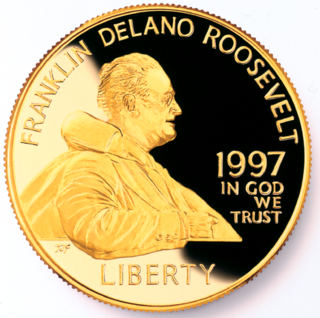 W
WThe Franklin Delano Roosevelt gold half eagle is a commemorative coin issued by the United States Mint in 1997.
 W
WThe George Washington gold half eagle is a commemorative coin issued by the United States Mint in 1999, the 200th anniversary of Washington's death.
 W
WThe gold dollar or gold one-dollar piece is a gold coin that was struck as a regular issue by the United States Bureau of the Mint from 1849 to 1889. The coin had three types over its lifetime, all designed by Mint Chief Engraver James B. Longacre. The Type 1 issue has the smallest diameter of any United States coin minted to date.
 W
WThe American Gold Eagle is an official gold bullion coin of the United States. Authorized under the Gold Bullion Coin Act of 1985, it was first released by the United States Mint in 1986. Because the term "eagle" also is the official United States designation for pre-1933 ten dollars gold coins, the weight of the bullion coin is typically used when describing American Gold Eagles to avoid confusion. This is particularly true with the 1/4-oz American Gold Eagle, which has a marked face value of ten dollars.
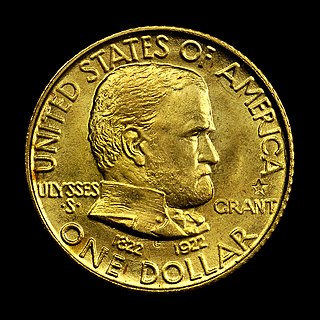 W
WThe Grant Memorial coinage are a gold dollar and silver half dollar struck by the United States Bureau of the Mint in 1922 in honor of the 100th anniversary of the birth of Ulysses S. Grant, a leading Union general during the American Civil War and later the 18th president of the United States. The two coins are identical in design and were sculpted by Laura Gardin Fraser.
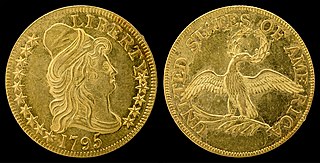 W
WThe half eagle is a United States coin that was produced for circulation from 1795 to 1929 and in commemorative and bullion coins since 1983. Composed almost entirely of gold, its face value of five dollars is half that of the eagle coin. Production of the half eagle was authorized by the Coinage Act of 1792, and it was the first gold coin minted by the United States.
 W
WThe half union was a United States pattern coin with a face value of fifty U.S. Dollars. It is often thought of as one of the most significant and well-known patterns in the history of the U.S. Mint. The basic design, featuring Liberty on the obverse, was slightly modified from the similar $20 "Liberty Head" Double Eagle, which was designed by James B. Longacre and minted from 1849 to 1907.
 W
WThe Indian Head eagle is a $10 gold piece or eagle that was struck by the United States Mint continuously from 1907 until 1916, and then irregularly until 1933. The obverse and reverse were designed by sculptor Augustus Saint-Gaudens, originally commissioned for use on other denominations. He was suffering from cancer and did not survive to see the coins released.
In 2007, the United States Mint released a gold five-dollar commemorative coin which commemorates the 400th year after the founding of Jamestown. Surcharges from the sale of the Jamestown commemorative were donated to Jamestown-Yorktown Foundation of the Commonwealth of Virginia, the Secretary of the Interior and the Association for the Preservation of Virginia Antiquities to support programs that promote the understanding of the legacies of Jamestown.
 W
WThe Lewis and Clark Exposition Gold dollar is a commemorative coin that was struck in 1904 and 1905 as part of the United States government's participation in the Lewis and Clark Centennial Exposition, held in the latter year in Portland, Oregon. Designed by United States Bureau of the Mint Chief Engraver Charles E. Barber, the coin did not sell well and less than a tenth of the authorized mintage of 250,000 was issued.
 W
WThe Liberty Head double eagle or Coronet double eagle is an American twenty-dollar gold piece struck as a pattern coin in 1849, and for commerce from 1850 to 1907. It was designed by Mint of the United States Chief Engraver James B. Longacre.
 W
WThe Louisiana Purchase Exposition gold dollar is a commemorative coin issue dated 1903. Struck in two varieties, the coins were designed by United States Bureau of the Mint Chief Engraver Charles E. Barber. The pieces were issued to commemorate the Louisiana Purchase Exposition held in 1904 in St. Louis; one variety depicted former president Thomas Jefferson, and the other, the recently assassinated president William McKinley. Although not the first American commemorative coins, they were the first in gold.
 W
WThe McKinley Birthplace Memorial gold dollar was a commemorative coin struck by the United States Bureau of the Mint in 1916 and 1917, depicting the 25th President of the United States, William McKinley. The coin's obverse was designed by Charles E. Barber, Chief Engraver of the Mint, and the reverse by his assistant, George T. Morgan. As McKinley had appeared on a version of the 1903-dated Louisiana Purchase Exposition dollar, the 1916 release made him the first person to appear on two issues of U.S. coins.
 W
WThe Mormon gold coinage consisted of privately-issued tokens which the Church of Jesus Christ of Latter-day Saints struck from 1848 to 1860. They were issued in $2.50, $5, $10, and $20 denominations.
 W
WThe five Panama–Pacific commemorative coins were produced in connection with the 1915 Panama–Pacific International Exposition in San Francisco. Struck at that city's mint, the issue included round and octagonal $50 pieces. Excepting modern bullion coins, these two gold pieces are the highest denomination ever issued and the largest coins ever struck by the United States Mint. The octagonal $50 piece is the only U.S. coin to be issued that is not round.
 W
WThe quarter eagle was a gold coin issued by the United States with a denomination of two hundred and fifty cents, or two dollars and fifty cents. It was given its name in the Coinage Act of 1792, as a derivation from the US ten-dollar eagle coin. Its purchasing power in 1800 would be equivalent to $71.12 in 2015 dollars.
 W
WThe Saint-Gaudens double eagle is a twenty-dollar gold coin, or double eagle, produced by the United States Mint from 1907 to 1933. The coin is named after its designer, the sculptor Augustus Saint-Gaudens, who designed the obverse and reverse. It is considered by many to be the most beautiful of U.S. coins.
 W
WThe United States four dollar coin, also officially called a Stella, is a unit of currency equivalent to four United States dollars.
 W
W"Territorial gold" refers to the gold token coins that began to be produced in U.S. territories at the time of the California Gold Rush. California gold coins were issued from 1849 to 1883; Mormon gold coinage in Utah Territory from 1848 to 1860; "beaver coins" in Oregon Territory in 1849; and gold coins in Colorado Territory from 1860 to 1861.
 W
WThe three-dollar piece was a gold coin produced by the United States Bureau of the Mint from 1854 to 1889. Authorized by the Act of February 21, 1853, the coin was designed by Mint Chief Engraver James B. Longacre. The obverse bears a representation of Lady Liberty wearing a headdress of a Native American princess and the reverse a wreath of corn, wheat, cotton, and tobacco.
 W
WThe Turban Head eagle, also known as the Capped Bust eagle, was a ten-dollar gold piece, or eagle, struck by the United States Mint from 1795 to 1804. The piece was designed by Robert Scot, and was the first in the eagle series, which continued until the Mint ceased striking gold coins for circulation in 1933. The common name is a misnomer; Liberty does not wear a turban but a cap, believed by some to be a pileus or Phrygian cap : her hair twisting around the headgear makes it resemble a turban.
 W
WThe Union was a proposed $100 coin of the United States dollar. It was canceled before any pattern coins could be minted.